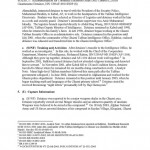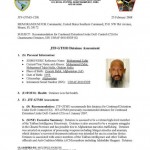In the news is the discussion of terminating parts of the Patriot Act and key uses the NSA was using. While having parts of the Patriot Act go dark is a good thing to protect our granted privacy rights, there is one section that will go dark and that is part in parcel the ‘lone-wolf’ section.
The condition or phenomenon known as lone wolf is a matter that needs some further attention as most recent attacks have been performed by units of lone wolves. Such was the case of Major Nidal Hassan, the Ft. Hood shooter as the recent case in Garland, Texas. Others include the attacks in Paris and in Australia.
It is suggested that you take the time to watch this video and continue the debate.
As it relates to the Patriot Act and up for debate is shown below:
A Summary by Mary DeRosa
Section 6001 of the Intelligence Reform and Terrorism Prevention Act of 2004, known as the “lone wolf” amendment, broadens FISA to allow surveillance of a new category of individuals. The provision amends FISA’s definition of “agent of a foreign power” to include any person, other than a U.S. person, who “engages in international terrorism or activities in preparation therefore.” Previously, that definition required a nexus to a foreign power or entity, such as a foreign government or an international terrorist organization. The expanded definition allows the government to use FISA for surveillance of a non-U.S. person who has no known ties to a group or entity. Congress passed this “lone wolf” provision because it was concerned that the previous FISA definitions did not cover unaffiliated individuals—or those for whom no affiliation can be established—who nonetheless engage or are preparing to engage in international terrorism.
The standards and procedures for FISA collection are different, more secretive, and in some cases less rigorous than those for law enforcement surveillance. But FISA is limited by its requirement that the target of surveillance be a foreign power or its agent. After this “lone wolf” provision, a target can be considered an “agent of a foreign power” without any evidence that they are acting with a group. But there must be probable cause that the target is engaging or preparing to engage in “international terrorism,” which FISA defines to be activities that involve violent, criminal acts intended to intimidate or coerce a population or a government and that occur totally outside of the United States or transcend national boundaries.
Section 6001(b) of the Intelligence Reform Act subjects the “lone wolf” amendment to the PATRIOT Act’s sunset provision. Therefore, unless reauthorized, the expanded authority will expire on December 31, 2005.
Targeting the Loosely-Affiliated Terrorist
by Michael J. Woods
Critics of FISA’s new “lone wolf’ provision argue it is a dangerous expansion of authority, allowing the application of FISA to individuals lacking any connection to foreign powers. The language actually enacted, however, integrates a definition of “international terrorism’ that preserves a sufficiently strong foreign nexus requirement. Therefore, the statute’s parts, taken together and read in context, contain adequate safeguards to ensure that the lone wolf provision will be used against its intended targets—international terrorists.
Before the lone wolf provision, there were two principal paths to obtain FISA surveillance of an international terrorist: first, by demonstrating probable cause that the target acts in the U.S. as a “member’ of an international terrorist group (found in FISA section 101(b)(1)(A)); and second, by demonstrating probable cause that the target “knowingly engages in sabotage or international terrorism, or activities that are in preparation therefor, for or on behalf of a foreign power’ (section 101(b)(2)(C)). The first option is difficult to establish given the informality of terrorist organizations and is not available where the target is a U.S. person. The second is the stock from which the present “lone wolf’ provision is cut, and provides the conceptual foundation for the new provision.
The legislative history of those two original FISA provisions, found primarily in House Report 95-1283, Senate Report 95-701 and House Conference Report 95-1720, reveals that the drafters’ chief concern here was to avoid application of the FISA to purely domestic terrorists or political dissidents. Congress was reacting to the Supreme Court’s 1972 holding in United States v. United States District Court (found at 407 U.S. 297, and commonly called the “Keith case’) that “domestic security surveillance’ was subject to the warrant and reasonableness requirements of the Fourth Amendment. The group at issue in Keith was a radical organization (the White Panther Party) that had bombed a number of federal facilities to draw attention to the group’s domestic social/political agenda. (See The Court Legacy, Vol. XI, No. 4 (Nov. 2003).) The Court emphasized that its Keith holding addressed only “the domestic aspects of national security’ and did not reach “the activities of foreign powers or their agents.’ FISA was the legislative approach to the area beyond Keith: the field of foreign intelligence surveillance. In addressing terrorism as a national security threat, the FISA drafters needed to draw a line between the purely domestic variety covered by the Keith ruling, and the activities of international terrorist organizations (which could take place in the United States).


